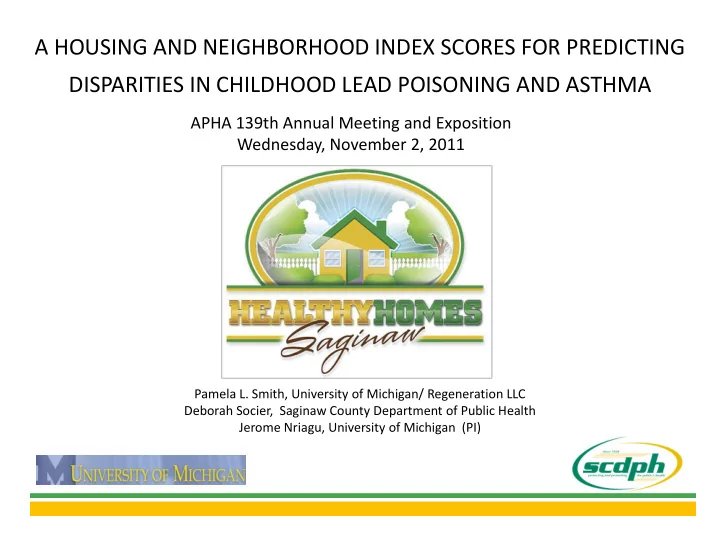

A HOUSING AND NEIGHBORHOOD INDEX SCORES FOR PREDICTING DISPARITIES IN CHILDHOOD LEAD POISONING AND ASTHMA APHA 139th Annual Meeting and Exposition Wednesday, November 2, 2011 Pamela L. Smith, University of Michigan/ Regeneration LLC Deborah Socier, Saginaw County Department of Public Health Jerome Nriagu, University of Michigan (PI)
Presenter Disclosures Pamela Pugh Smith The following personal financial relationships with commercial interests relevant to this presentation existed during the past 12 months: “ No relationships to disclose ”
Specific Study Objectives 1)Develop a household hazard index (HHI) and neighborhood hazard index (NHI) and combined household and neighborhood (HNI) rating scale. 2)Evaluate the associations of HHI and NHI with elevated blood lead (ebl) and asthma in children.
Household Hazard SCALES Structural 18 Items Mold 8 Items Pets 4 Items Pests 6 Items Ventilation 6 Items Fire 6 Items Electrical 7 Items Lifestyle and 12 Items Behavioral
NEIGHBORHOOD HAZARD SCALE Neighborhood Satisfaction (12 Items) Perception of (6 Items) Neighborhood Condition Exterior Housing (13 Items) Observation Neighborhood Hazards (21 Items) (Observational)
Study Site
Data Collection 15,351 Households Screened Household Members: 642 Households • ≤ 12yrs; or Surveyed • Pregnant; and Household HHI no • Resident > 3 months Score ≥ 53 no NO Does Child Have Intervention Exclusion Asthma or Blood Lead Level ≥ 10 g/dL no yes Basic Interventions Basic + Extensive Interventions ~20 200
Findings – Child Health Outcome Children (n=1211) number % Children w/Asthma 212 17.8% Initial BLL ≥ 10µg/dL 18 1.5% Households (n=642) number % Households with One 144 23% Asthmatic Child Households with Two 21 3.4% Asthmatic Children Households with 3-4 8 1.3% Asthmatic Children
Prevalence Rates Asthma Rate in Comparison 25% 21% 19% 20% Percent 15% 13% 12% 11% 11% 10% 10% 7% 6% 5% 0% U.S. MI Study Population Age 0-4 5.7% 6.9% 11.4% Age 5-9 10.6% 13.3% 19.4% Age ≥ 10 10.4% 11.8% 21.3%
Prevalence Rates Age 120% 100% 18% 22% 25% 28% Percent 80% 40% 33% 60% 39% 37% 40% 44% 42% 20% 37% 35% 0% Children BLL ≥ 10µg/dL Asthmatic HHI≥53 (n = 1211) (n =18 ) (n = 211) (n =400) Age 0-4 28.2% 22.2% 18.0% 24.7% Age 5-9 36.6% 33.3% 39.8% 38.6% Age ≥ 10 35.3% 44.4% 42.2% 36.6%
Prevalence Rates Income 100% 80% 43.3% 52.4% 54.9% 70.6% 60% Percent 40% 21.8% 24.2% 25.6% 11.1% 11.8% 20% 9.5% 7.2% 5.9% 18.9% 13.9% 11.8% 12.3% 0% BLL ≥ Children HHI≥53 10µg/dL Asthma Less than $19,999 0.433 0.706 0.549 0.524 $20,000-$34,999 0.218 0.118 0.256 0.242 $35,000-$49,999 0.111 0.059 0.072 0.095 $50,000 or more 0.1888 0.118 0.123 0.139
Prevalence Rates Race & Ethnicity 120% 100% Percent 80% 39.3% 43.8% 55.6% 61.6% 60% 36.5% 40% 33.2% 22.2% 18.0% 20% 9.8% 8.6% 11.1% 7.1% 14.4% 13.3% 14.4% 11.1% 0% Children BLL ≥ 10µg/dL Asthmatic HNI≥53 (n = 1211) (n =18 ) (n = 211) (n =400) African Amer. 0.438 0.556 0.616 0.393 White 0.332 0.222 0.18 0.365 Hispanic/Latino 0.086 0.111 0.071 0.098 Other 0.144 0.111 0.133 0.144
Distribution - HHI
Distribution - HHI
Distribution – Disease Burden
Distribution – Child Asthma
Crude Odds Ratios - HHI ≥ 53 95.0% CI for OR Odds (p-value) Ratio Lower Upper Neighborhood .000 1.054 1.024 1.084 Satisfaction Perception of Neighborhood .000 1.125 1.076 1.176 Condition Respiratory/Lung/ .001 1.797 1.257 2.568 Breathing Problems Asthma .003 1.763 1.214 2.562 Household Disease .000 1.130 1.105 1.155 Burden
Next Steps Further Tool Validation. • Query additional neighborhood risk factors. • Further assessment of the relative impact of household, neighborhood, and behavioral hazards.
Questions Pamela Pugh Smith (989) 992-6353 pamela@urbanregenerationllc.com Jerome Nriagu (734) 936-0706 jnriagu@umich.edu
Recommend
More recommend